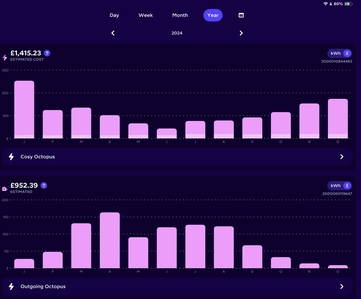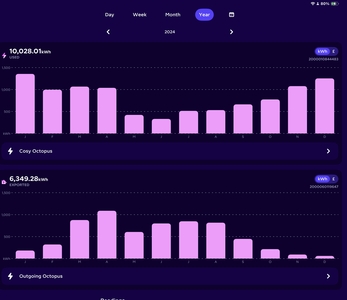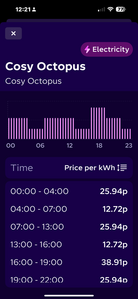@old_scientist Another point I might have made a little more clearly is that I put ‘consumption’ for 2025 as this figure includes some 600+ kWh used just to charge battery on each of the 30 days and without this battery charging, my actual consumption was ~450 kWh or less. It will be very interesting to see how your figures pan out over the more favourable summer months. Regards, Toodles.
Toodles, he heats his home with cold draughts and cooks his food with magnets.
Posted by: @toodles@old_scientist Another point I might have made a little more clearly is that I put ‘consumption’ for 2025 as this figure includes some 600+ kWh used just to charge battery on each of the 30 days and without this battery charging, my actual consumption was ~450 kWh or less. It will be very interesting to see how your figures pan out over the more favourable summer months. Regards, Toodles.
@toodles Indeed. On a tariff such as IOF where import and export prices are the same, the only thing that really matters is the difference between consumption and generation, i.e what is the net export for the period. Due to round trip losses, I grant it will be more efficient if there were less grid charging and more solar charging or the battery, but that is more than offset by the fact that you've dumped your battery at peak rate (29.8p) in the first place.
Our summer usage is ~10-12kWh per day. Our generation with the extra solar panels should be 10-50kWh/day (50kWh on a perfect cloud free mid-summer day).
Looking at my own numbers for the first half of summer (April - June), we would have been around £45-50 better off had we been on IOF, and that's without exporting 10kWh per day at peak rate. Extrapolate that to be around £100 for the 6 month period April to September, and then factor in we are also doubling our solar capacity, all of which will be exported at 22.36p giving maybe another £500 plus, and I think we'll have £600 in credit to carry into winter (although not this winter). With the additional solar generation in winter, I'm hoping we will be very close to being net zero cost for the year.
The other aspect I like of combining IOF in summer with Cosy in winter is that every kWh we export in summer (at 22.36p) buys us back 1.5kWh of heat in winter (at 12.91p and allowing for 15% round trip losses), or 2kWh heat in winter for exporting at peak rate (29.82p) in summer (based on current rates). That really does incentivise us to minimise our usage in summer to maximise our budget for winter.
Samsung 12kW gen6 ASHP with 50L volumiser and all new large radiators. 7.2kWp solar (south facing), Tesla PW3 (13.5kW)
Solar generation completely offsets ASHP usage annually. We no longer burn ~1600L of kerosene annually.
@old_scientist I am attaching the consumption and solar production figures in kWh and in monetary value for last year. Cosy tariff applied along with Outgoing fixed for the export for most if not all the time. (I would need to go back through my bills to be sure.) Regards, Toodles.
Toodles, he heats his home with cold draughts and cooks his food with magnets.
Are there any new kWh rates out at the moment?
We don’t have solar pv so we don’t have to worry about import/export. Just electric purchase price.
4 bed, 18c house with solar hot water.
Our total 12 month consumption was 5602kwh…
est breakdown is 2468 kWh for heat pump
and 3134 kWh for all other elec. no gas, no wood burner.
We are on a 19p per unit rate and when I did the math on a comparison with 15p/23p with Ovo we were more or less level on cost without the yoke of avoiding peak usage or trying to cram in consumption in a narrow time band. Also - is that the most efficient way to use a heat pump?
Where is the low hassle low cost supplier? Any thoughts?
@sunandair Without battery storage, I am not sure that OE’s Cosy would provide any benefit, but here are the rates in my area (SE). Regards, Toodles.
Toodles, he heats his home with cold draughts and cooks his food with magnets.
I've been on Octopus Agile for the last couple months. It's a dynamic tariff for those with a smart meter and the pricing changes every 30mins. I've been able to achieve a net import price below 15p for the last couple of months, but you do need to be able and prepared to load shift to the cheaper times to take full advantage.
Samsung 12kW gen6 ASHP with 50L volumiser and all new large radiators. 7.2kWp solar (south facing), Tesla PW3 (13.5kW)
Solar generation completely offsets ASHP usage annually. We no longer burn ~1600L of kerosene annually.
I’m guessing it’s been a bumper crop for surplus solar the past 3 months.. do you have any experience of agile when it’s cloudy or dull?
local household exporters near me seem to be complaining earlier in the year about agile rates for a short time but that might be just hearsay.
It sounds like it’s worth a closer look. Thanks.
Posted by: @sunandairI’m guessing it’s been a bumper crop for surplus solar the past 3 months.. do you have any experience of agile when it’s cloudy or dull?
local household exporters near me seem to be complaining earlier in the year about agile rates for a short time but that might be just hearsay.
It sounds like it’s worth a closer look. Thanks.
I've been on Agile import for coming up to two years. The key to getting the best from it is to go all-in with your home automation so that you can ensure you're not pulling from grid at the expensive times (particularly the 4pm - 7pm stretch). To be frank, that has a far bigger effect than whether it's sunny or cloudy. The other big one is, if you have an EV, making best use of the times of negative pricing.
I've just gone through a quick exercise in working out average cost per unit and, during the time I've been on Agile import, it has worked out at an average of 21p/kWh. That is excluding standing charge and including the Vodka and Tonic. My average export price for the same time period is 13p/kWh. What it does not, however, show, is the extent to which my import consumption has dropped as a result of the home automations.
It's easy to complain about prices in the short term but the longer term trends can say a different story.
105 m2 bungalow in South East England
Mitsubishi Ecodan 8.5 kW air source heat pump
18 x 360W solar panels
1 x 6 kW GroWatt battery and SPH5000 inverter
1 x Myenergi Zappi
1 x VW ID3
Raised beds for home-grown veg and chickens for eggs
"Semper in excretia; sumus solum profundum variat"
There was a period during last winter (Dec and maybe Jan) where pricing on Agile got VERY expensive, and this is the chance you take although you can switch away to another Octopus tariff instantly (same day), so you do need to be constantly monitoring the pricing and shifting your usage accordingly. If doing this isn't for you or you don't have a way to automate it, then Agile isn't for you.
I switched away from Agile in mid December when the pricing went through the roof and switched back again at the start of April. I've averaged 15p in April, 10p in May and 11p in June for our imports on Agile, and I can't always take advantage of very cheap daytime rates as we have to use our solar first before we start drawing from the grid. I have no doubt Agile is a significantly cheaper tariff than the SVR for us.
Samsung 12kW gen6 ASHP with 50L volumiser and all new large radiators. 7.2kWp solar (south facing), Tesla PW3 (13.5kW)
Solar generation completely offsets ASHP usage annually. We no longer burn ~1600L of kerosene annually.
@old_scientist Whereas, with battery storage, I find the ‘security blanket’ of Cosy cheapest rate (3 + 3 + 2 hours per day), easy on the management side with little or no hassle; the current rate of a little under 13 p. + VAT per kWh a safe bet. I receive 15 p. per kWh for all export so the small difference means I don’t worry too much about whether I export it all and import at cheapest rate, or just export all excess energy without any importing. Come the Autumn of course, this will all change again. Regards, Toodles.
Toodles, he heats his home with cold draughts and cooks his food with magnets.
Posted by: @old_scientist...
I switched away from Agile in mid December when the pricing went through the roof and switched back again at the start of April. I've averaged 15p in April, 10p in May and 11p in June for our imports on Agile, and I can't always take advantage of very cheap daytime rates as we have to use our solar first before we start drawing from the grid. I have no doubt Agile is a significantly cheaper tariff than the SVR for us.
Yes. Just focusing on specific months, our average import prices were 18p in April, 11p in May and 8p in June. Our exports in the same period have been about two thirds of the import cost, with May and June being a net profit.
105 m2 bungalow in South East England
Mitsubishi Ecodan 8.5 kW air source heat pump
18 x 360W solar panels
1 x 6 kW GroWatt battery and SPH5000 inverter
1 x Myenergi Zappi
1 x VW ID3
Raised beds for home-grown veg and chickens for eggs
"Semper in excretia; sumus solum profundum variat"
-
Ripped Off: How UK Homeowners Are Paying Gas Prices for Wind Energy
1 day ago
-
Agile: average import cost vs other tariffs?
2 months ago
-
Switching tariff in Winter? or stick year round?
10 months ago
-
Confusion over Octopus Tariffs
1 year ago
-
Octopus tariffs - API & choosing best tariff
2 years ago
Currently viewing this topic 4 guests.
- 26 Forums
- 2,104 Topics
- 46.3 K Posts
- 130 Online
- 3,393 Members
Join Us!
Latest Posts
-

@pie_eater Try asking the Perplexity AI engine how to t...
By downfield , 4 hours ago
-
RE: No-code, plug-and-play monitoring for your heat pump
Just in case anyone is looking at Planet Atmo- we've ma...
By benson , 4 hours ago
-
RE: Victorian Semi Retrofit / Extension ASHP and UFH Advice
Agree, but you may have a hard time convincing them, as...
By JamesPa , 6 hours ago
-
RE: Seal the Deal: Don't Let Your Heat Pump Leak Energy
Hi - fyi - there's a dead image link in the 'Optimal In...
By seatonian , 23 hours ago
-

RE: Ripped Off: How UK Homeowners Are Paying Gas Prices for Wind Energy
@chandykris Horses and beggars…. 😉 Toodles.
By Toodles , 1 day ago
-

RE: Cleaning up after gas meter removed
@agentgeorge Likewise in the loft space; we have 300mm ...
By Toodles , 1 day ago
-
RE: Ecodan consuming 100kwh per day in new build!!!
This particular example is one of the worst I have seen...
By JamesPa , 1 day ago
-

-
RE: Fan running in hot weather ...why?
I wonder if it has some kind of pressure transducer to ...
By ASHP-BOBBA , 2 days ago
-
RE: Cooling with Samsung Gen6 and Flow error
@iaack The system isnt running long enough for any cond...
By EcoBaker , 2 days ago
-
@heacol thanks for confirming we can only hope NAPIT ag...
By Bart , 2 days ago
-

RE: BUS Grant: removal of all other fossil fuel heat sources
@editor If it is of any interest, we had the BUS grant,...
By Toodles , 3 days ago
-

Sorry to hear that @bruce. Sadly I’ve heard from multip...
By Mars , 4 days ago
-
RE: Crystal Ball Time: Communal or even Area Energy Storage?
I am invested in a couple of listed energy storage fund...
By Old_Scientist , 4 days ago
-

RE: Who's your electricity provider and what's your tariff?
That would be my biggest commitment -time to gain great...
By SUNandAIR , 4 days ago
-

RE: Who has a V2G EV installation
As has been discussed on other threads, trying to justi...
By Majordennisbloodnok , 5 days ago
-
RE: Aira Heat Pump: Stylish Scandinavian Heating
Thanks @mikeh. Then I will also go back to non smart ta...
By ChandyKris , 5 days ago







